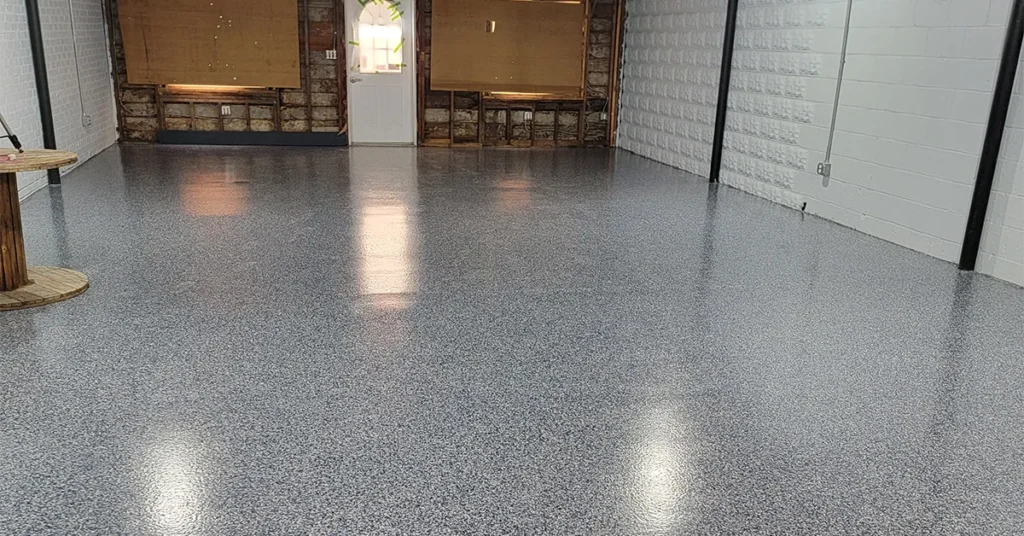Your basement probably looks like most basements. Cold concrete floor. Maybe some stains from the water heater leak three years ago. A place where you throw stuff you don’t know what to do with. But what if that space could actually be somewhere you want to hang out?
That’s where an epoxy basement floor comes in. I’m talking about turning what’s basically a dungeon into a space that actually adds value to your home and your daily life.
Why Epoxy Is The Best Choice For Basements
Here’s the thing about basements. They deal with moisture. They’re underground, they’re cooler, and humidity loves to hang out down there. Regular flooring options either can’t handle it or cost a fortune. The carpet gets musty. Wood warps. Tile is cold and expensive to install.
Epoxy coating is different. It actually thrives in the conditions that ruin other floors. That concrete slab in your basement is the perfect surface for epoxy to bond to. And once it’s on, it creates a moisture barrier that protects the concrete underneath while providing a surface that’s much easier to live with.
Additionally, basements are typically a single, large open space. That makes installation cleaner and often more affordable than coating multiple smaller rooms.
The Real Benefits You’ll Actually Notice
Let me break down what changes when you coat your basement floor with epoxy. Not the marketing talk, but the stuff you’ll actually appreciate day to day.
Moisture Doesn’t Stand a Chance
Most quality epoxy base coats come with built-in moisture barriers. This is huge for basements. When you have that sealed coating on your floor, water can’t seep up from below. It can’t sit in the concrete and create that damp smell. No more wondering if moisture is slowly damaging your foundation.
The Temperature Difference Is Real
Bare concrete freezes in the winter. Concrete coating creates a layer that actually makes the floor feel warmer under your feet. If you’re turning your basement into a living space where people will actually spend time, this matters more than you’d think.
Cleaning Becomes Ridiculously Easy
This might be my favorite part. You know how basement floors collect dust and dirt and just look dingy, no matter what you do? With epoxy, you literally just sweep or mop. That’s it. No scrubbing stains. No need to wonder if you’re making it worse. The coating is completely sealed, so nothing soaks in.
It Actually Looks Good
Let’s be honest, concrete is ugly. Even when it’s clean, it’s boring. An epoxy basement floor can completely transform the space’s ambiance. You can add color flakes for texture and style. Choose a solid color that complements your vision. Try metallic finishes that look like polished stone. The transformation is pretty dramatic.
Your Basement Becomes Usable Space
This is the big one. When your basement floor looks good and stays dry and is comfortable to be in, you actually use the space. Home gym? Game room? Kids’ play area? Home office? All of these work way better on a coated floor than bare concrete.
Design Ideas To Match Your Vibe
Okay, so if you’re thinking about doing this. Here are some ideas based on what people are actually choosing and what works well in basements.
Classic Flake Floors
This is the most popular choice for good reason. You pick a base color, then scatter decorative flakes into it while it’s wet. The flakes add texture so the floor isn’t slippery, and they create visual interest that hides dirt and small imperfections.
Solid Color Modern Look
If you’re going for clean and contemporary, a solid color epoxy basement floor is sharp. Grays are popular due to their versatility, as they work with everything. But you could do a deep blue, a warm tan, even a crisp white if you’re feeling bold.
Metallic Epoxy
Want something that makes people say, “whoa, what is that?” Metallic epoxy systems create depth and dimension that can look like polished stone, marble, or even flowing patterns. These are more expensive and require serious skill to install, but the result is basically art on your floor. Perfect if you’re creating a high-end entertainment space or home bar.
Terrazzo-Style with Larger Flakes
Think of this as the classic flake floor’s cooler older sibling. Instead of small flakes, you use larger decorative chips in multiple colors. It creates a terrazzo look that’s modern but also timeless. Works great for basements you’re turning into rental units or teen hangout spaces.
Border and Design Details
Here’s something most people don’t think about: you can add different colors in specific areas. A border around the perimeter. A different color for where you’re putting your gym equipment. This adds visual zones without needing walls or dividers.
Breaking Down the Cost
Epoxy flooring costs typically depend on several factors. The material quality has a huge impact on the cost and makes a huge difference. Professional-grade systems with high solids content cost more but last longer and perform better. The solids percentage basically tells you how pure the coating is. Higher percentages mean better durability and protection.
Your basement’s current condition matters too. If the concrete is smooth and in good shape, great. If there are cracks, uneven areas, or existing coatings that need removing, that adds to the cost. Sometimes, basements require moisture testing first to ensure there are no underlying problems.
Design choices impact the price. A basic solid color costs less than metallic finishes or complex patterns. More decorative flakes or multiple colors increase material costs.
But here’s the perspective to keep in mind: other basement flooring options either cost similar amounts or require way more maintenance. And if you’re planning to use the space regularly, the epoxy basement floor cost pays for itself in durability and easy upkeep.
Things Nobody Tells You Until It’s Too Late
Before you jump in, here’s the real talk about what you need to know.
Your Concrete Needs Time
If you just poured a new basement floor, you have to wait at least 28 days before coating it. The concrete needs to cure completely, and all the moisture needs to evaporate. Rush this, and your coating won’t bond properly.
Moisture Problems Need Fixing First
If your basement has active water issues, like leaks or serious seepage, you need to address those before coating. Epoxy is amazing at handling normal basement moisture, but it’s not magic. Fix the source problems first.
Some Furniture Will Need to Move
This sounds obvious, but you need to completely clear the floor. Water heaters, washers, dryers, storage shelves, everything. Some installers will help move stuff, others won’t. Ask upfront so you’re not surprised.
The Smell During Installation
Epoxy has a chemical odor while it’s being applied and during the curing process. It’s not horrible, but you’ll want to ventilate the space. Open windows, run fans, and consider planning to be out of the house for the first day.
Winter Installations Can Be Tricky
Epoxy needs temperatures above 50 degrees to cure properly. Many basements stay cool year-round. Some installers bring heaters to maintain the right temperature. Just something to coordinate if you’re doing this in colder months.
Comparing Your Options
So, how does an epoxy basement floor compare to other options?
Bare concrete is cheap but looks terrible and is cold and hard. Sealed concrete is better, but it is still cold and shows every stain. Basement carpet seems cozy until it gets damp and starts to smell. The tile looks nice, but it costs a fortune to install and is even colder than concrete.
Vinyl flooring is popular for basements because it’s cheap, but it can peel up with moisture and doesn’t add any structural protection to your concrete. Luxury vinyl plank looks good initially, but doesn’t seal the floor underneath.
Epoxy provides moisture protection, temperature improvement, easy maintenance, and attractive appearance all in one system. When you factor in how long it lasts with minimal upkeep, the value makes sense.
FAQs
How long will an epoxy basement floor actually last?
With proper installation using quality materials, you’re looking at 15-20 years or even longer. Basements actually tend to be easier on epoxy than garages because you’re not driving cars over them.
What if my basement floor already has cracks?
This is totally normal and not a deal-breaker. Part of the prep work includes filling all cracks with special filler material. Small hairline cracks get sealed. Larger cracks get repaired and reinforced. The epoxy coating then goes over everything, creating a smooth, sealed surface.
Can I turn my basement into a living space after coating the floor?
Absolutely, and that’s actually one of the best reasons to do this. An epoxy basement floor makes the space way more livable. It’s warmer underfoot than bare concrete, it stays clean easily, and it looks finished.
Is the floor going to be slippery when wet?
Not if it’s installed correctly. When you add decorative flakes to the base coat, they create texture that provides traction. The polyaspartic top coat isn’t slick like some people think.
What about that basement smell? Does epoxy help?
Yeah, actually. A lot of that musty basement smell comes from moisture in the concrete and dampness that creates mildew. When you seal your floor with an epoxy coating, you’re cutting off a major source of that moisture.
Can I do this myself to save money?
I’m going to be straight with you. Most DIY epoxy jobs in basements fail within a year or two. The surface preparation requires expensive equipment, such as diamond grinders. The mixing ratios have to be exact.
Conclusion
Your basement has potential. It’s probably the largest unused square footage in your home. An epoxy basement floor is one of the most practical upgrades you can make to unlock the space’s potential and actually start using it. Additionally, when you eventually sell, a finished basement with a high-quality epoxy floor adds significant value that buyers will notice.
The right installer matters more than anything else. Get multiple quotes. Ask to see their previous work. Make sure they explain what system they’re using and why. A good contractor will test your concrete for moisture issues, discuss your specific basement conditions, and recommend the right combination of products.
At the end of the day, you’re not just coating a floor. You’re creating a space that works for how you actually live. And that’s worth doing right.


